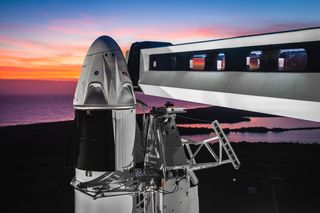SpaceX's new astronaut taxi has been cleared for a historic liftoff next weekend.
All systems are go for the planned March 2 launch of the Crew Dragon capsule on its first test flight to the International Space Station (ISS), an uncrewed mission known as Demo-1, NASA and SpaceX officials announced today (Feb. 22).
They came to this conclusion after conducting an in-depth appraisal known as a flight readiness review (FRR), which was geared in large part to ensure the safety of the ISS and the three people currently living there.
"We need to make sure that [Crew Dragon] can safely go rendezvous and dock with the space station, and undock safely, and not pose a hazard to the International Space Station," Kathy Lueders, manager of NASA's Commercial Crew Program, said during a news conference this afternoon.
Related: How to Watch SpaceX's Crew Dragon Demo-1 Test Flight Live

The first Crew Dragon is scheduled to lift off atop a SpaceX Falcon 9 rocket from Pad 39A of NASA's Kennedy Space Center in Cape Canaveral, Florida, on March 2 at 2:48 a.m. EST (0748 GMT). You can watch the launch live here on Space.com when the time comes. SpaceX has backup launch dates available on March 5 and March 8 or 9 if the first attempt is delayed.
SpaceX has been developing Crew Dragon since 2014 under a $2.6 billion contract with NASA. The agency signed a similar deal (but worth $4.2 billion) with Boeing, which is building its own capsule called the CST-100 Starliner. The goal is to bring crewed orbital launch back to U.S. soil, a capability the nation lost when NASA retired its space shuttle fleet in 2011. NASA currently depends entirely on Russian Soyuz rockets and spacecraft to get its astronauts to and from the ISS, at a cost of about $80 million per seat.
Get the Space.com Newsletter
Breaking space news, the latest updates on rocket launches, skywatching events and more!
Crew Dragon is based on SpaceX's robotic Dragon cargo capsule, which has been flying resupply missions to the International Space Station since 2012 under a different deal with NASA. There are a number of important differences, however.
Most obviously, Crew Dragon has seven seats, a life-support system and a touch-screen console for astronauts to use. The crew capsule also features eight SuperDraco escape engines, which would fly the vehicle out of harm's way during a launch emergency.
Crew Dragon docks directly to the ISS, whereas the cargo version is grabbed by the orbiting lab's huge robotic arm. And the crew variant has its solar panels built into its trunk, while cargo Dragon has more traditional deployable solar arrays.
Related: Take a Walk Through SpaceX's Crew Dragon Spaceship
Demo-1 will test Crew Dragon's many systems from end-to-end, from launch to the capsule's parachute-aided Atlantic Ocean splashdown six days later. Data collection will be aided by a spacesuit-clad, sensor-laden dummy that will fly on the mission, SpaceX representatives said.
The FRR revealed a few minor potential issues with various Crew Dragon systems, including its thrusters and parachute, NASA officials said. But such flagging is normal for uncrewed demonstration flights, and the team expects to identify and rectify any problems before Crew Dragon flies astronauts for the first time.
"I fully expect we're going to learn something on this flight," Bill Gerstenmaier, associate administrator for NASA Human Exploration and Operations, said during today's news conference. "I guarantee that everything will not work exactly right, and that's cool — that's exactly what we want to do."
If all goes well with Demo-1, this same Crew Dragon capsule will then launch on an uncrewed high-altitude abort test, which will press the SuperDracos into service. NASA has said this test is planned for June, though SpaceX CEO Elon Musk recently mentioned April as a potential target date.
Demo-2, which will carry two NASA astronauts to and from the ISS, is expected to launch in July. Operational, contracted missions will follow. Boeing's CST-100 Starliner is scheduled to fly its first uncrewed test mission to the ISS no earlier than April.
"Human spaceflight is basically the core mission of SpaceX, so we are really excited to do this," said Hans Koenigsmann, SpaceX vice president of Build and Flight Reliability. "There's nothing more important to us than this endeavor."
Mike Wall's book about the search for alien life, "Out There" (Grand Central Publishing, 2018; illustrated by Karl Tate) is out now. Follow him on Twitter @michaeldwall. Follow us on Twitter @Spacedotcom or Facebook.
Join our Space Forums to keep talking space on the latest missions, night sky and more! And if you have a news tip, correction or comment, let us know at: community@space.com.

Michael Wall is a Senior Space Writer with Space.com and joined the team in 2010. He primarily covers exoplanets, spaceflight and military space, but has been known to dabble in the space art beat. His book about the search for alien life, "Out There," was published on Nov. 13, 2018. Before becoming a science writer, Michael worked as a herpetologist and wildlife biologist. He has a Ph.D. in evolutionary biology from the University of Sydney, Australia, a bachelor's degree from the University of Arizona, and a graduate certificate in science writing from the University of California, Santa Cruz. To find out what his latest project is, you can follow Michael on Twitter.
